You’ll find Page is all about red-rock drama and sunlit water, where slot canyons hum with color and the lake mirrors sky in perfect blue. Walk simple overlooks or push into backcountry narrows with Navajo guides, taste wind on a boat deck, and aim your lens at impossible light. This list walks you through the top hikes, tours, overlooks, and quiet spots—enough to plan a day or a week, and to keep you plotting one more stop.
Antelope Canyon (Upper and Lower)
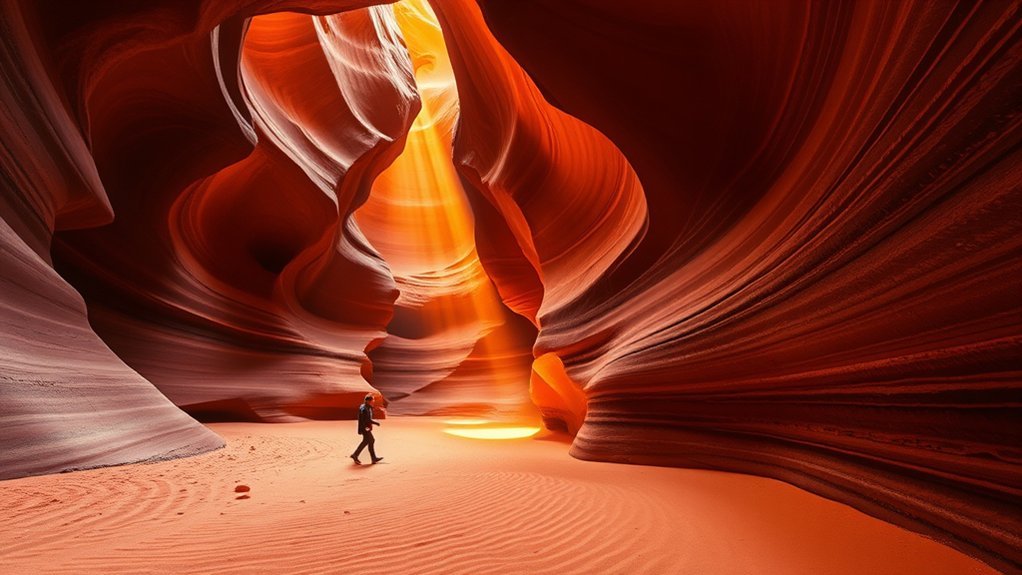
Step into Antelope Canyon and you’ll feel the sandstone breathe light—narrow walls curl around you in smooth, satiny ribbons, catching beams that turn dust motes into drifting gold. You’ll hike into Upper’s sinuous, photogenic slots where sunlight slashes through at midday, ideal for striking photos and brief, contemplative pauses. In Lower, you’ll climb narrow ladders and thread tighter passages, sensing the cool, fine-grained walls under your fingertips. Guided tours are required—Navajo guides share geology, cultural history, and safety details while controlling group size to protect these fragile formations. Bring water, a wide-angle lens, and sturdy shoes; avoid tripods unless the tour allows them. Visit in shoulder seasons or early morning to dodge crowds and harsh light. Respect the canyon: stay with your guide, don’t touch the walls, and carry out any trash. When you emerge, you’ll carry an image of curved, polished stone and a quiet understanding of how wind and flash floods carved this sculpted world.
Horseshoe Bend Overlook
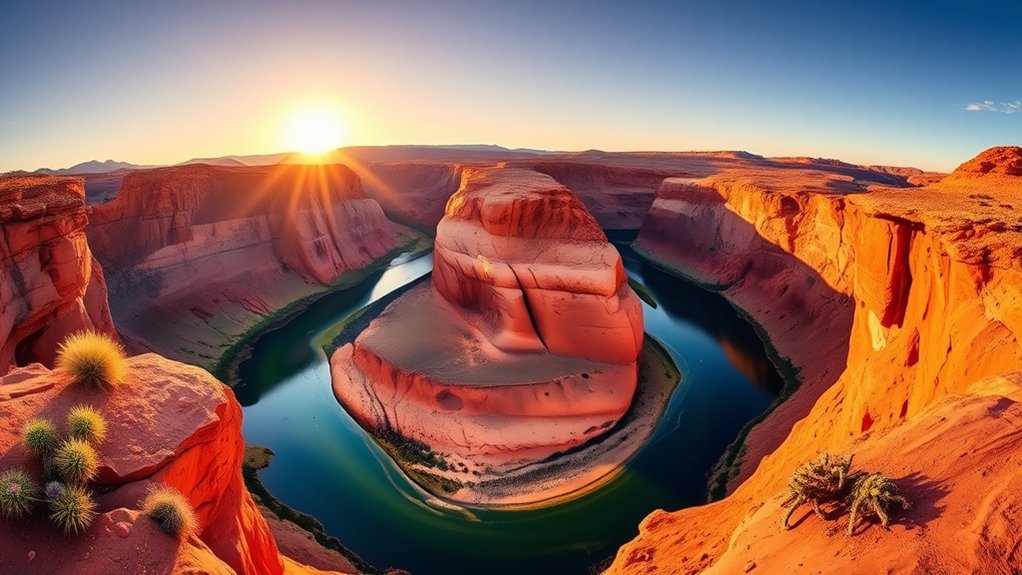
You’ll want to time your visit to Horseshoe Bend for sunrise or late afternoon light when the canyon glows and the crowds thin. Walk the short but sandy trail from the parking area—plan for heat, bring water, and allow a few extra minutes for the overlook and photos. Stay behind the railings and respect viewpoint signage so you can safely enjoy the dizzying river bend and sweeping vistas.
Best Time to Visit
If you visit at sunrise or just before sunset, the light wraps the canyon in warm golds and long shadows that make Horseshoe Bend’s curve pop against the Colorado River below. Those hours are cooler, quieter, and the air smells faintly of sun-baked sand and sage. Midday brings harsh light and heat; colors wash out and the rim crowds thicken. Aim for shoulder seasons—spring and fall—for milder temperatures and blooming desert plants, though winter offers crisp clarity and dramatic low-angle sun. Bring a light jacket for breezy evenings and sunscreen for bright mornings. Stay aware of changing light: an hour before and after golden hour yields the richest hues and the best chances for unobstructed, unforgettable views.
How to Get There
Although the overlook sits only a few miles from Page, getting there feels like a small pilgrimage: you’ll follow a paved, well-marked road out of town, park at the official lot, and walk a short but sun-exposed trail to the rim where the bend unfurls below. You’ll pay the small parking fee or use the shuttle in busy months, then lace up shoes for sandy, uneven footing. The sun hits the sandstone hard; bring water, a hat, and sunglasses. The trail is easy but exposed, with occasional wind that smells like dust and juniper. Signs guide you, and the final approach opens to wide red cliffs and a sudden drop that frames the Colorado River. Keep to the path.
Safety and Viewpoints
Once you reach the rim and the river unfurls, pay attention to safety while you soak in the views: the cliff edges are unguarded in many spots, wind can gust without warning, and the sandstone can crumble underfoot. You’ll feel the heat radiate from sun-baked rock and hear the Colorado carving below; keep a steady stance, stay back from the lip, and watch children and pets closely. Use the official overlook paths and signs, step on compacted trail instead of fragile varnish, and wear sturdy shoes with grip. If fog or high winds roll in, postpone risky framing for clearer light. Bring water, a hat, and a camera strap—let the sweep of canyon and river fill your senses without jeopardy.
Lake Powell Boat Tour
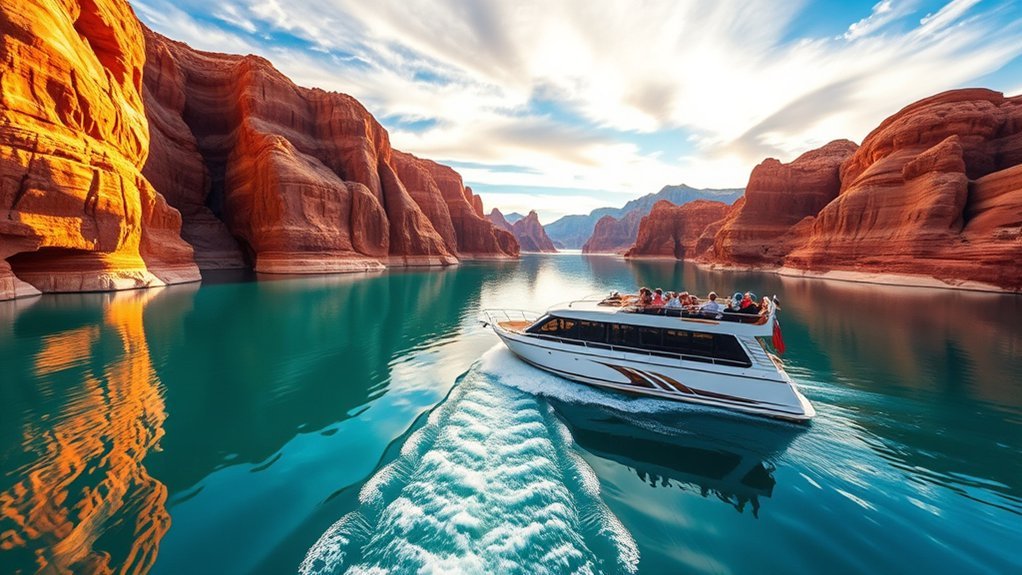
A boat ride on Lake Powell feels like slipping through a living postcard — red-rock cliffs rising straight from glassy blue water, sunlight carving gold into sandstone curves as you glide past hidden coves and towering buttes. You’ll feel the boat’s gentle thrum underfoot, smell sun-warmed cedar and desert dust, and watch sunlight fracture into sparkles on the water. Choose a guided cruise for history and geology commentary, or rent a speedboat to explore slot canyons and quiet inlets at your own pace. Bring layered clothing, sun protection, and plenty of water; winds can shift and shade is limited. Photographers will love dramatic contrasts at golden hour; anglers can try striped bass in deeper channels. Look for towering arches, side canyons with sculpted walls, and beaches perfect for a picnic swim. Whether you seek calm reflection or spirited exploration, a Lake Powell boat tour delivers immersive scenery and memorable closeness to the Colorado Plateau’s sculpted edge.
Glen Canyon National Recreation Area
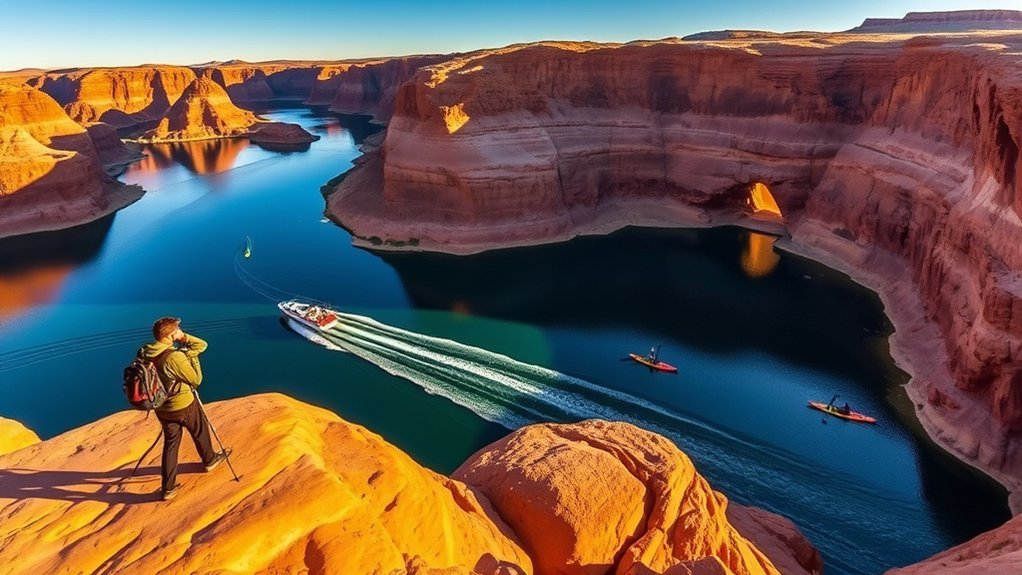
You’ll feel the sun on your face as you glide across Lake Powell, watching sandstone cliffs melt into the water while your boat threads hidden coves. From Glen Canyon you can plan kayak trips and houseboat stays that put you right at the edge of Antelope Canyon’s shadowed slot entrances. Book guided access for Antelope Canyon and ranger info for Lake Powell to make the most of both experiences.
Lake Powell Boating
Slide out onto Lake Powell and feel the heat lift off the sun-baked sandstone as wind tugs at the boat’s bow; the water flashes electric blue against towering red walls, and every cove promises a new discovery. You’ll pilot between carved cliffs, watching light and shadow slide across Navajo sandstone while splashes cool your skin. Rent a powerboat, kayak, or houseboat—each lets you reach secluded beaches, hidden arches, and drift into slot canyons above the waterline. Keep binoculars for bighorn sheep and osprey; pack shade, plenty of water, and sunscreen—the sun’s intensity surprises. Watch reservoir levels on park advisories and practice wake etiquette near fragile shorelines. At sunset, anchor in a calm bay and let the canyon absorb the day’s color.
Antelope Canyon Access
After a day on Lake Powell’s blue mirror, head inland where sunlight threads through narrow sandstone ribs and paints Antelope Canyon in molten amber. You’ll approach via guided tour—private hikes into the slot require permits and local outfitters control access—so book ahead, especially in peak season. As you descend the short stairways, the temperature softens, and the sandstone hums with history. Light shafts at midday carve luminous ribbons; early and late visits offer cooler tones and fewer people. Bring water, a wide-angle lens, and closed-toe shoes for sandy footing. Respect Navajo rules: no climbing, no tripods unless allowed, and stay with your guide. Your visit will feel intimate, reverent, and unmistakably otherworldly.
Rainbow Bridge National Monument
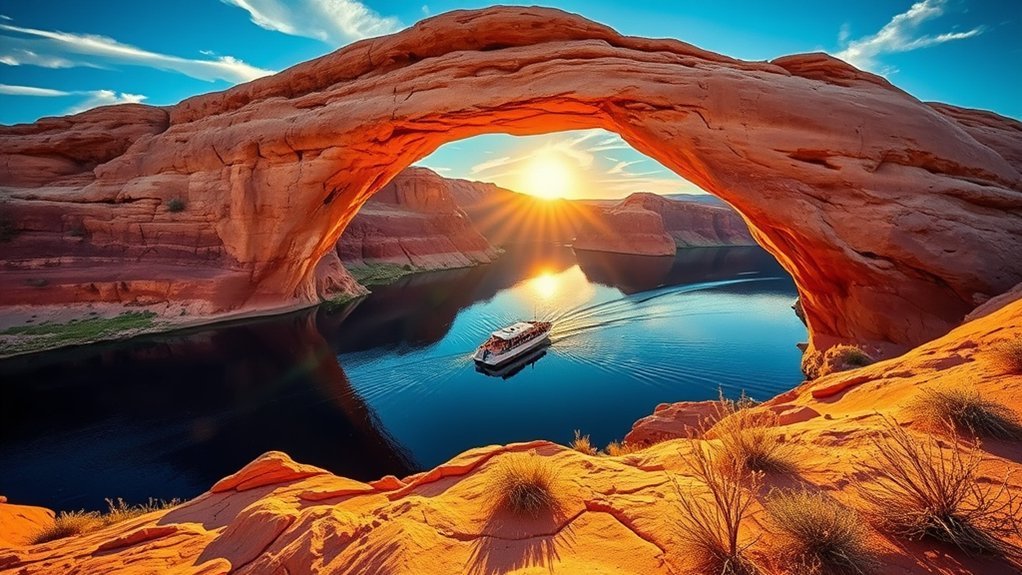
Ancient stone arches frame a sudden, breathtaking gateway where the Colorado River has carved a natural bridge so monumental you’ll feel both small and awed; Rainbow Bridge National Monument rises roughly 290 feet above the water, its curving sandstone glowing in shades of red and gold at sunrise and casting cool, shadowed recesses in the heat of day. You approach by boat or a demanding hike, and the scale hits you: the arch spans like a cathedral, wind and water still visible in every smoothed groove. Listen for the river’s steady chant, smell warm, iron-rich stone, feel grit under your shoes. Respect the site’s cultural significance and leave no trace.
- Sunlight washing the arch in molten ochre and rose.
- River spray cooling your face as boats slide past.
- Honeycombed sandstone textures under fingertip light.
- Deep shadows pooling beneath the bridge, cool and blue.
Navajo Village Heritage Center
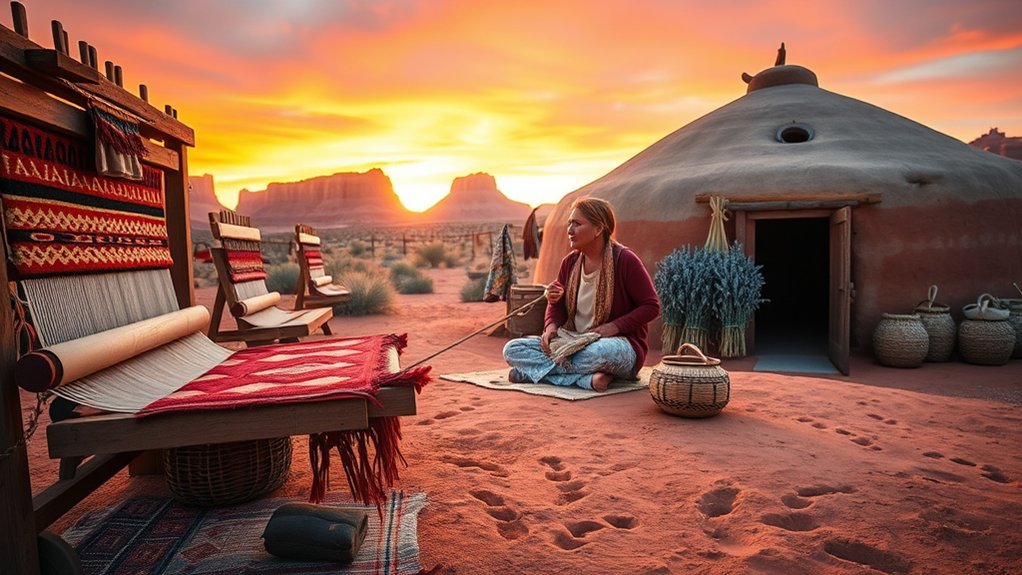
Step into the Navajo Village Heritage Center and you’ll feel the rhythm of daily life unfold—the scent of cedar smoke, the click of loom threads, the low cadence of stories told in Navajo and translated for visitors. You’ll walk among replica hogans and meet artisans who show traditional weaving, silverwork, and sandpainting techniques. Touch the coarse wool yarn, watch shuttle movements, and hear explanations that link patterns to clan histories and seasonal cycles. Guides share practical insights about livestock, water use, and ceremonial roles without overwhelming you with jargon. Seasonal demonstrations—sheep butchering, corn grinding, or ceremonial song—give context to Navajo sustainability and resilience. The small museum displays tools, garments, and photographs that anchor oral histories to objects. You’ll leave with a clearer sense of daily rhythms shaped by land and language, and with respectful curiosity about practices still lived today. Stop in the gift shop to support artists and bring home an authentic, meaningful memento.
Slot Canyon Photography Tour
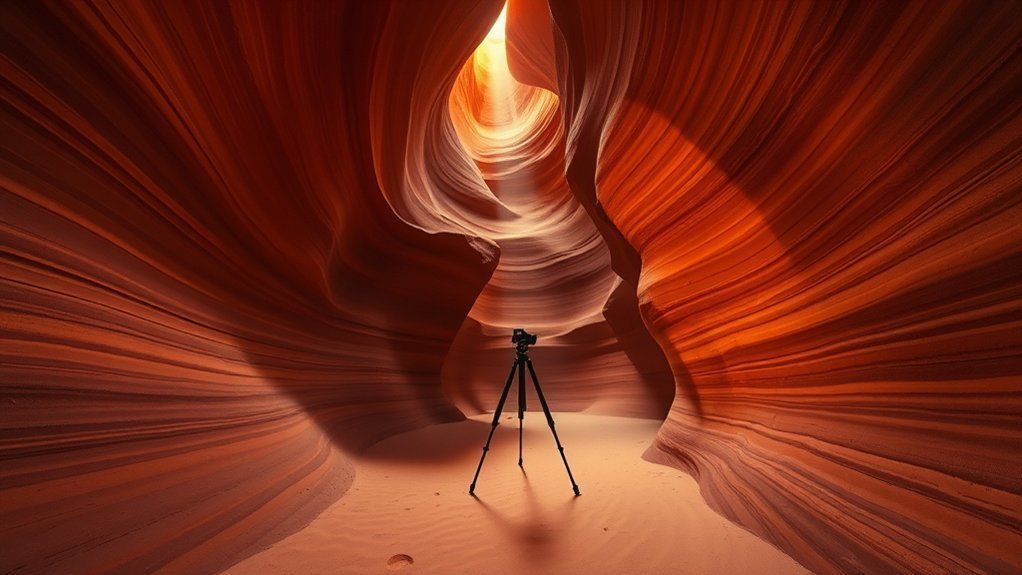
Hit the canyon at golden hour or mid-afternoon when light shafts paint the sandstone in molten oranges and soft purples. Bring a wide-angle lens, a sturdy tripod, and a polarizer or neutral-density filter to capture the textures and long exposures through low-light narrows. Keep ISO low, shoot RAW, and scout compositions quickly so you can savor the colors before they shift.
Best Light Times
Usually mid-morning and early afternoon give the most dramatic beams in the slot canyon, when the sun sits high enough to send thin, golden shafts through narrow openings and paint the sandstone in saturated reds, oranges, and purples. You’ll feel warmth on your skin as light slices the cool shadowed walls, revealing striations and soft dust motes floating like tiny stars. Plan visits around that window for the strongest contrast; late morning often balances beam intensity with accessible angles. Overcast days mute colors but bring even, painterly textures. Early morning offers gentle pastels and solitude; late afternoon deepens shadows and brings richer, moodier tones.
- sunbeams cutting vertical shafts
- warm highlights on rippled rock
- cool, blue shadows in crevices
- floating dust illuminated like haze
Camera Gear Tips
After you’ve timed the light to catch those molten beams and floating dust, think about what gear will let you capture that atmosphere. Bring a sturdy, compact tripod for long exposures and precise framing in tight curves. Choose a wide-angle lens (16–35mm) to emphasize sweeping walls, plus a 24–70mm for mid-range detail. Pack a fast prime if you want pin-sharp shafts with shallow depth. Use low ISO and shoot RAW to retain highlight detail in sunlit bands and shadow texture. Carry spare batteries and a microfibre cloth—the canyon’s fine sand coats contacts and glass. Consider a small LED for subtle fill or backlighting, and a remote release to avoid camera shake. Travel light; every ounce matters in narrow passages.
Page Rim View Trail
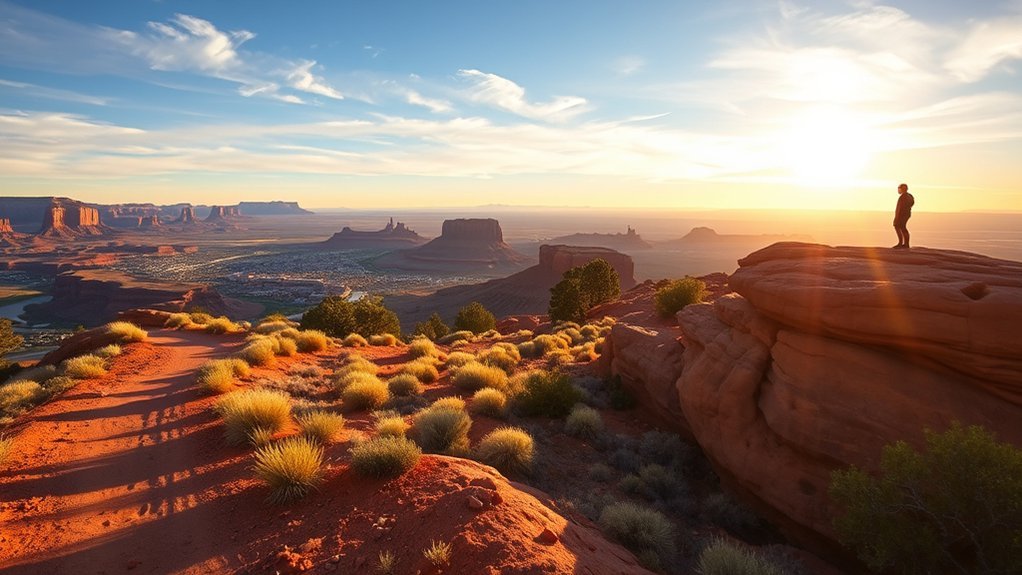
If you follow the rim trail at sunrise, you’ll feel the canyon’s heat give way to cool, sharp air and watch colors spill across strata like paint. You step onto the Page Rim View Trail and find a simple path that rewards you with expansive overlooks, wind-swept junipers, and quiet where the desert seems to exhale. The trail is easy to moderate, with packed dirt, occasional rock steps, and short spur vistas that beg you to stop and listen — to desert birds, distant water, the faint scrape of a lizard. Bring water, sun protection, and sturdy shoes; the exposure is honest and the views are your reward. As you walk, note how light sculpts the cliffs, how shadows reveal hidden ledges, and how perspective flattens then deepens the canyon’s layers.
- Red sandstone curves glowing in morning light
- Sharp silhouettes of mesa and scrub
- Cool breeze on sun-warmed skin
- Faraway river shimmer and hush
Hanging Garden Trail
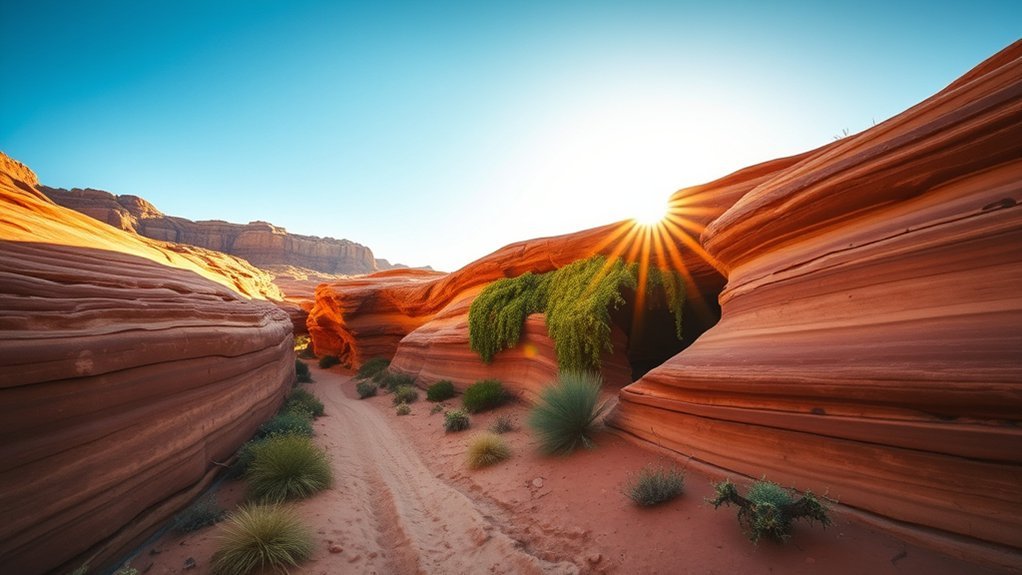
You’ll find the Hanging Garden Trail just off the main road, a short, shaded path that’s easy to access and great for a quick nature break. As you walk, feel the cool spray from mossy walls and listen to water trickling where pockets of green cling to the cliff. Pause at the ledges and alcoves for the best views—sunlight filtering through leaves makes the hanging gardens glow against the red rock.
Trail Overview and Access
Though tucked just off Highway 89, the Hanging Garden Trail feels like a secret carved into red rock—you’ll follow a short, well-marked path that quickly drops into a narrow alcove where cool spray and ferns contrast the sun-baked desert. The trail is easy, under a mile round-trip, with packed sand and occasional stone steps; it’s family-friendly but can be slick after rain. Parking sits at a small lot with clear signage, and a brief, shaded approach keeps you sheltered from midday sun. Bring sturdy shoes, water, and a light jacket for the mist. Trail etiquette asks you to stay on the path to protect roots and moss.
- damp stone underfoot
- dripping veils of water
- bright green fern fronds
- echoing, hushed alcove sounds
Best Viewing Spots
After following the shaded approach into the alcove, pause where the path widens and let your eyes adjust—the best views concentrate at three spots: the damp ledge just past the last stone step, a shallow recess to the left where fern fronds spill over the rock, and the small overhang near the trail’s end that frames the dripping veils against sunlit sandstone. Move slowly: the ledge offers close-up textures—mineral streaks, moss, and water beads catching light. The recess gives a cool, fern-scented pocket and a sense of enclosure perfect for photographs. The overhang lets you watch thin sheets of water fall over red and gold walls, creating shimmering reflections on the wet floor. Stay quiet, breathe in earthy humidity, and let the details register.
Wahweap Overlook
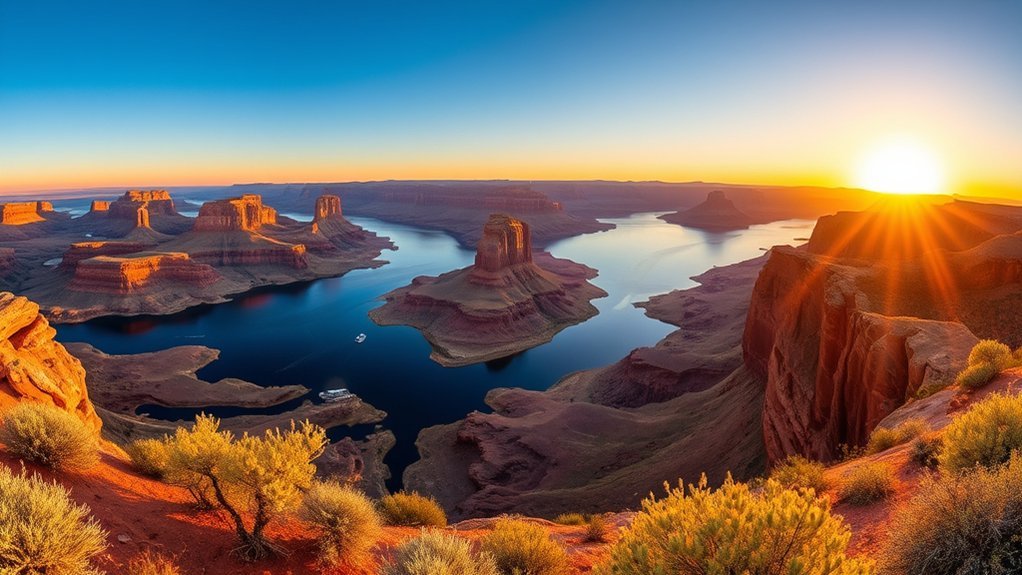
Perched above the winding arms of Lake Powell, Wahweap Overlook gives you a sweeping, cinematic view where rust-red cliffs plunge into cobalt water and sunlight fractures across sandstone ripples. You’ll feel the desert breeze on your face, smell hot stone and juniper, and watch yachts shrink to toy size in coves carved by ancient rivers. The paved pullout and short trail make it easy to pause, photograph golden-hour light, or just stand quietly as shadows march across canyons.
- A panoramic sweep: layered mesas and buttes stacked like weathered pages.
- Water contrasts: glassy blue inlets cupped by serrated orange cliffs.
- Textures up close: sun-baked sandstone, lichen speckles, and wind-polished edges.
- Light drama: dawn and dusk paint deep purples, burnt sienna, and molten gold.
You won’t need special gear to enjoy the view—just arrive with water, a hat, and patience for the changing light.
Lone Rock Beach and Recreation Area
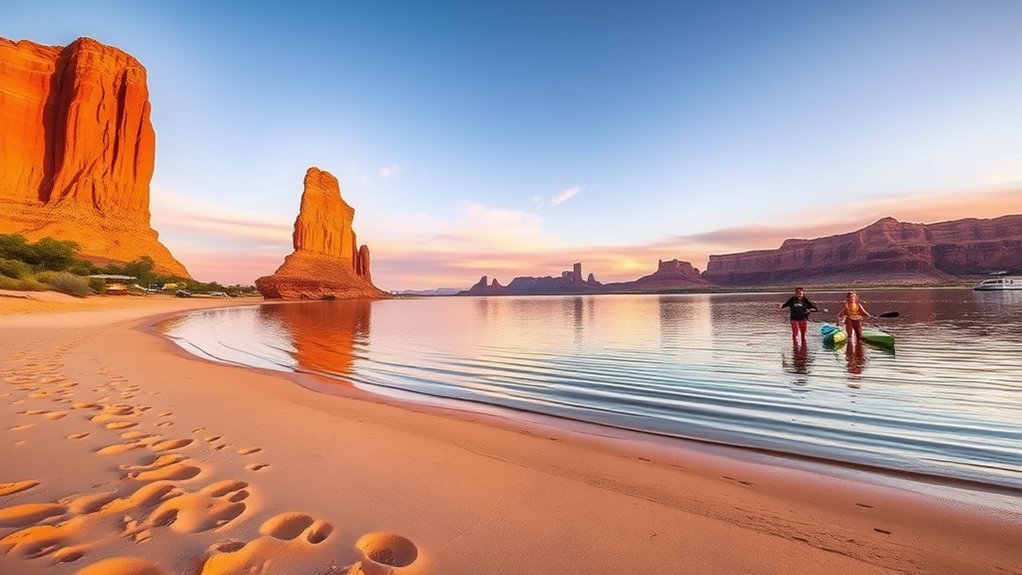
Pull up to the wide sweep of Lone Rock Beach and you’ll feel the desert open into a shoreline—soft sand, warm stone, and the wind’s salty bite off Lake Powell. You can step from your vehicle onto broad, level sand framed by honey-colored cliffs; the iconic Lone Rock rises like a sentinel where water laps its base. Bring a kayak or paddleboard and slide into calm coves, or wade where water reflects the sky’s sharp blues. Camping is informal but regulated—reserve a spot if you want an overnight under vivid stars, and pack water, shade, and sun protection; the sun is relentless. Watch for changing water levels that reshape the beach and expose sculpted sandstone. Birdlife moves through reeds; you’ll spot herons and occasional raptors. Facilities are minimal—vault toilets and informal fire rings—so leave no trace. Lone Rock gives you accessible Lake Powell access with dramatic scenery, easy launch points, and a feeling of wide, open space.
Navajo Nation Scenic Drive
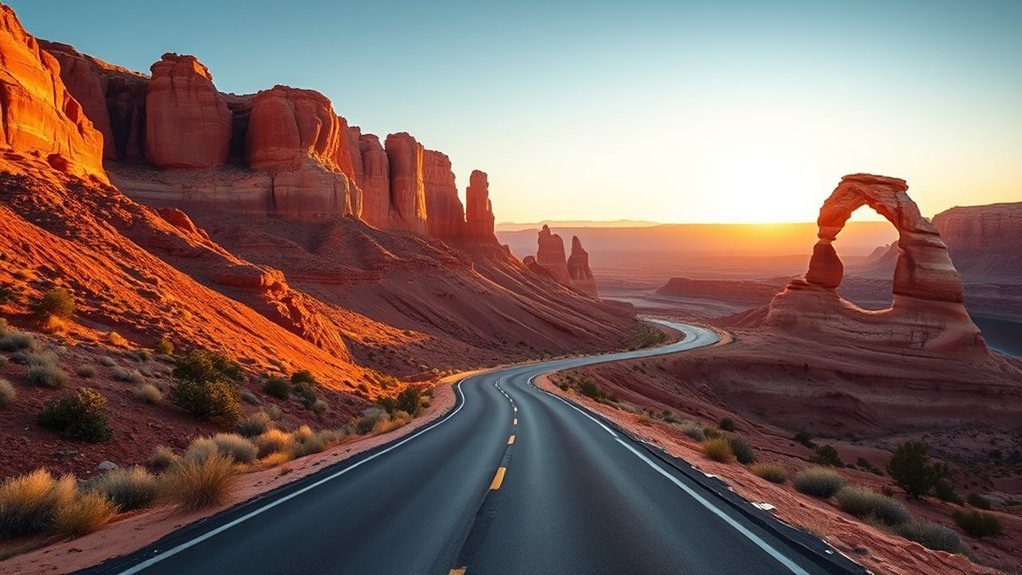
When you turn onto the Navajo Nation Scenic Drive, the road unfurls through a landscape of rust-red mesas, braided washes, and time-polished buttes, and every mile feels like a slow reveal of the Colorado Plateau’s sculpted geology. You’ll feel the air sharpen with a dry, mineral tang as sunlight chisels shadows across layered cliffs. Pull over where viewpoints appear; the silence hums with wind and distant ravens.
- A ridge-top lookout where you can smell juniper and watch light slide down a canyon wall.
- A wash crossing where exfoliated sandstone peels in warm flakes under your fingertips.
- A solitary butte framed by heat shimmer, its base dotted with resilient sagebrush.
- A roadside alcove where Navajo sheep graze and the horizon reads like a geology atlas.
Drive slowly, photograph thoughtfully, and respect cultural signs—this road threads living land, not just scenery.
Vermilion Cliffs National Monument (including Paria Canyon)
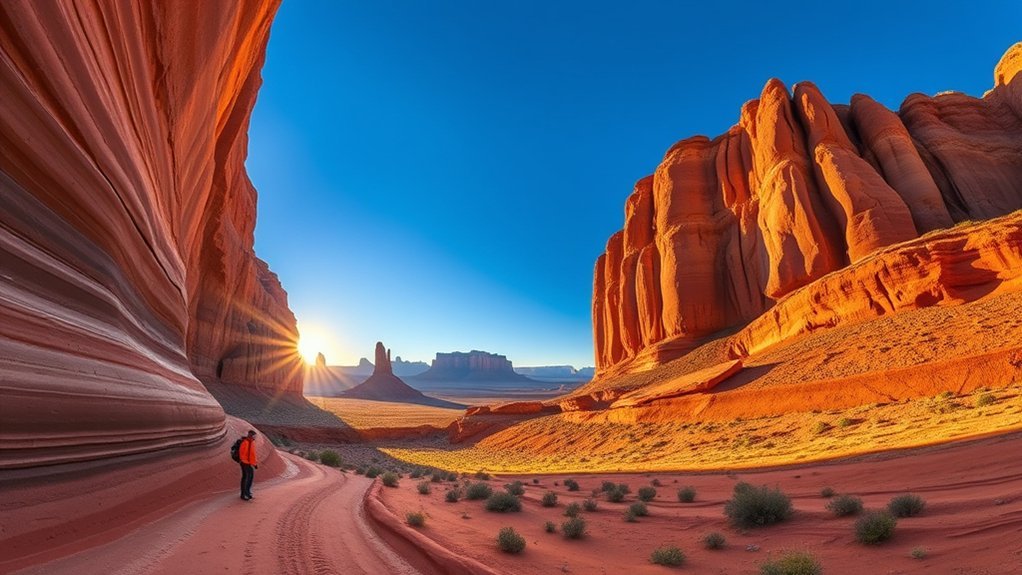
Though rugged and remote, Vermilion Cliffs National Monument grabs you the moment the road crests and a sweep of rust-red escarpments, checkerboarded plateaus, and narrow slot canyons stretches to the horizon; the land smells of sun-baked sage and iron, and wind-carved layers tell a slow, visible history. You’ll find stark contrasts: sheer cliffs dropping into green riparian corridors where cottonwoods and tamarisk cling to Paria River bends. Hike into Paria Canyon and you’ll trade broad panoramas for intimate walls—water-polished sandstone, fossil imprints, and shafts of light that change the color of the rock by the minute. Permits and planning matter here; you’ll need to reserve overnight river-canyon trips and respect fragile cryptobiotic soils. Bring water, sun protection, and a map—cell service is sparse. Wildlife sightings (bighorn sheep, raptors) reward patience. Whether you drive scenic overlooks, scramble short slickrock routes, or commit to a multi-day canyon trek, Vermilion Cliffs offers raw, contemplative desert wilderness that feels absolutely ancient.
Horseshoe Bend Sunset Hike
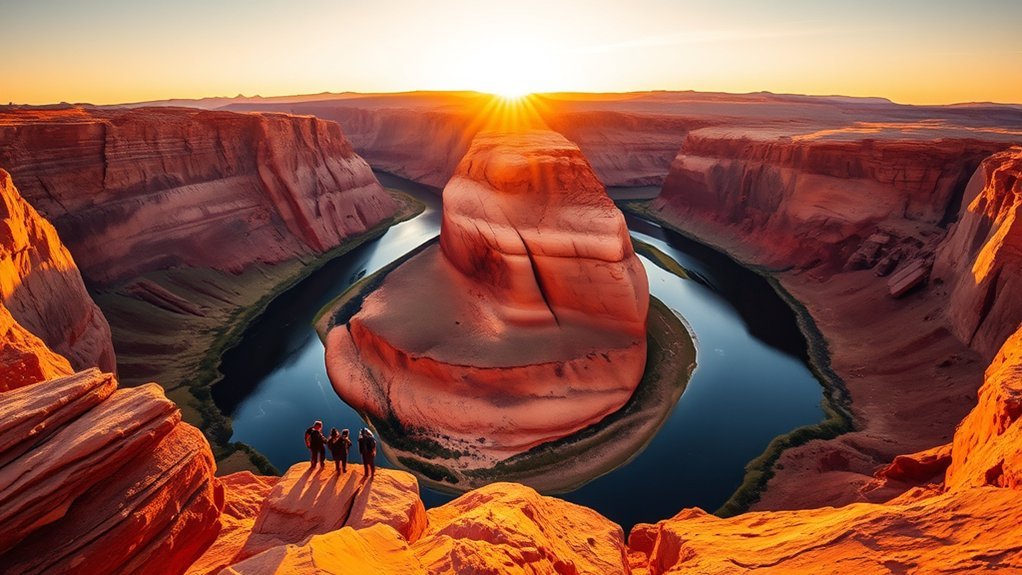
From the rust-red solitude of Vermilion Cliffs, it’s a short drive to a single, unforgettable bend where the Colorado River curls like a ribbon of glass—Horseshoe Bend at sunset is a study in light and scale. You’ll hike a short, sandy trail that gains a modest ridge; the walk sharpens your ears to wind and the scrape of sandals, and your shoulders loosen as anticipation builds. Arrive early to choose a vantage; the rim drops away to vertigo, the river catching molten gold and then indigo. Shadows lengthen; the canyon exhales cooling air.
- Orange cliffs glowing, edges carved by millennia.
- River reflections like liquid silver beneath you.
- Warm breeze carrying desert dust and distant sage.
- Sky shifting from buttery yellow to deep violet.
Bring water, a headlamp for the return, and a camera—yet don’t forget to pause and simply watch the light change.
Goulding’s Ferry Trail
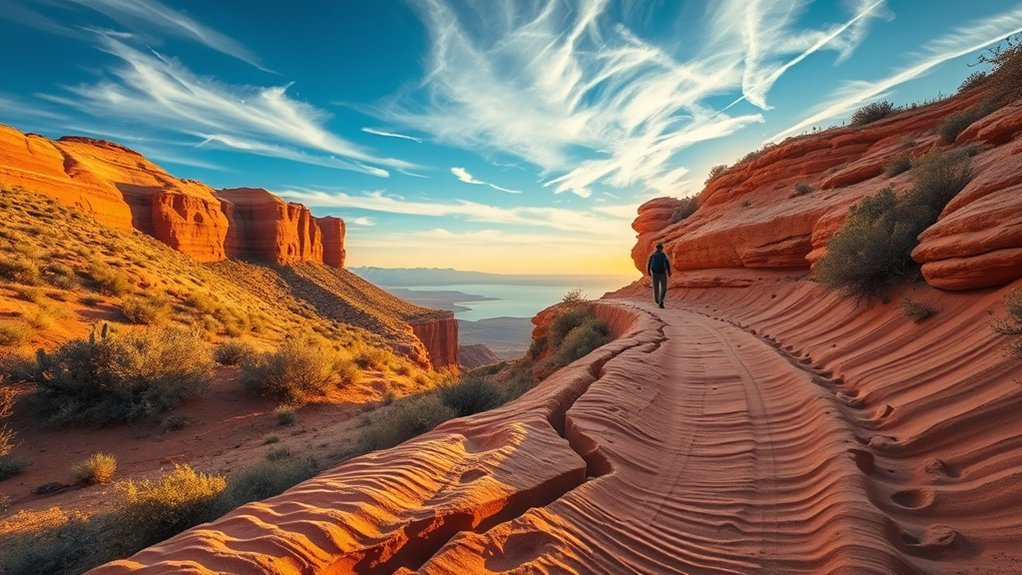
Step onto Goulding’s Ferry Trail and you’ll feel the landscape change beneath your boots — the path skirts ancient river terraces, climbs low sandstone ridges, and opens onto wide views where the Colorado once braided through this basin. You’ll notice warm sandstone underfoot, the dry tang of desert sage, and the echo of wind through stubby junipers. The trail is short and steady; it rewards attention with layered horizons, petroglyph-scattered alcoves, and sudden windows framing distant buttes. Bring water, sun protection, and a camera for textured light at golden hour. Early morning yields cool air and clear clarity; late afternoon softens shadows and deepens color. The route suits hikers who like quiet geology lessons and easy scrambling, not technical climbs. Stay on tread to protect cryptobiotic soil and fragile plants. The trail’s intimacy makes you feel part of the plateau’s slow story, where footsteps trace old river routes and the desert keeps its patient, tactile secrets.
| Feature | Sensation | Tip |
|---|---|---|
| Terrain | Warm, gritty | Sturdy shoes |
| Views | Layered, wide | Sunrise/sunset |
| Wildlife | Small, furtive | Move quietly |
Carl Hayden Visitor Center and Dam View
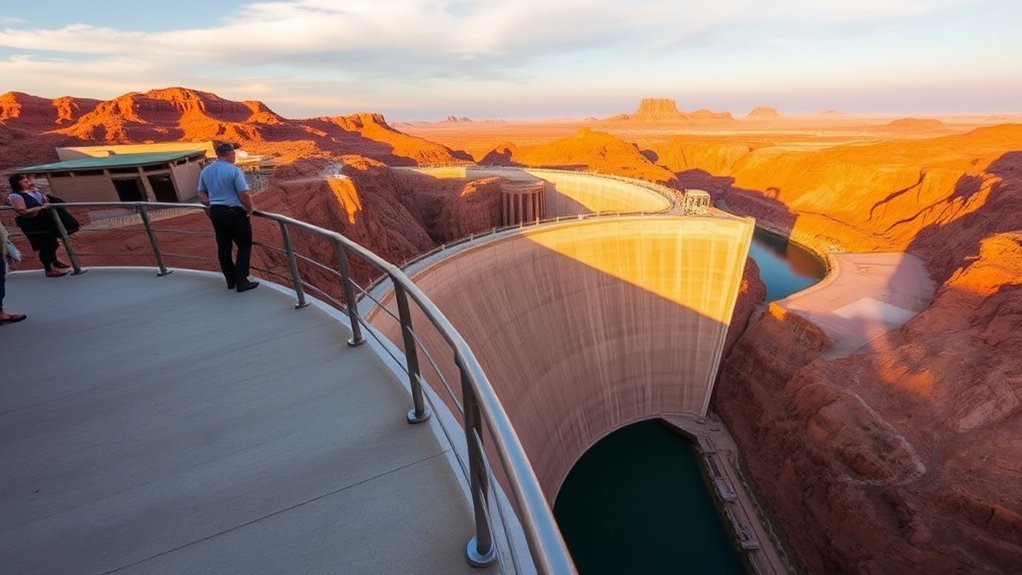
Step into the Carl Hayden Visitor Center and you’ll feel the cool hum of hydroelectric history through hands-on exhibits and large-scale photos. Ask about guided dam tours to walk catwalks, hear turbine roars, and learn how the structure tames the Colorado River. Then step out to the scenic overlooks where sunlit water, towering concrete, and red canyon walls create a view you won’t forget.
Visitor Center Exhibits
Head into the Carl Hayden Visitor Center and you’ll be greeted by panoramic windows framing the dam’s sheer concrete face while interactive exhibits unpack the engineering, history, and hydrology that shaped this place. You’ll feel the cool air, hear quiet audio narrations, and track water’s journey from snowmelt to turbine. Touchscreens let you manipulate flow diagrams; archival photos make construction dust and voices seem almost present.
- A scale model of the dam with moving water that glints under exhibit lights.
- Original black-and-white photos showing crews clambering over concrete ribs.
- An audio station playing oral histories—voices taut with effort and pride.
- Interactive maps that let you trace river routes, reservoirs, and downstream communities.
Spend a focused hour and you’ll leave grounded in context.
Dam Tour Details
After you’ve soaked in the exhibits, make your way outside to the dam tour and Dam View platform where the scale and sound of water become immediate—wind lifts spray from the spillways, sunlight slices across concrete, and the Colorado crests and eddies below. You’ll join a ranger-led walk that explains Hoover Dam’s sibling role in regional water management, power generation, and engineering feats. Expect clear commentary about intake towers, penstocks, and turbines, paired with measured safety briefings. Bring layers; spray and canyon winds can chill. Binoculars help you pick out structural details and river flow patterns. Photography is allowed from designated spots, but heed barriers and signs. The tour sharpens your sense of how human design shapes a vast, moving landscape.
Scenic Overlooks
While the visitor center’s glass and the Dam View platform frame the canyon differently, both give you sweeping perspectives that make the scale of Glen Canyon and the Colorado River feel immediate and tactile—you’ll see sun-glint on water, the striated canyon walls, and the dam’s geometric lines juxtaposed against raw rock. You’ll step into cool shade at the Carl Hayden Visitor Center, hear distant water, read interpretive panels, and watch light crawl down sandstone. At Dam View you’ll feel wind off the reservoir, photograph crisp silhouettes, and trace the river’s slow choreography through the gorge.
- Golden light melting across red rock.
- Glass reflections doubling canyon depth.
- Concrete dam cutting a clean horizon.
- Wind-carried river scent and echoing gull cries.
Jet Ski and Kayak Rentals on Lake Powell
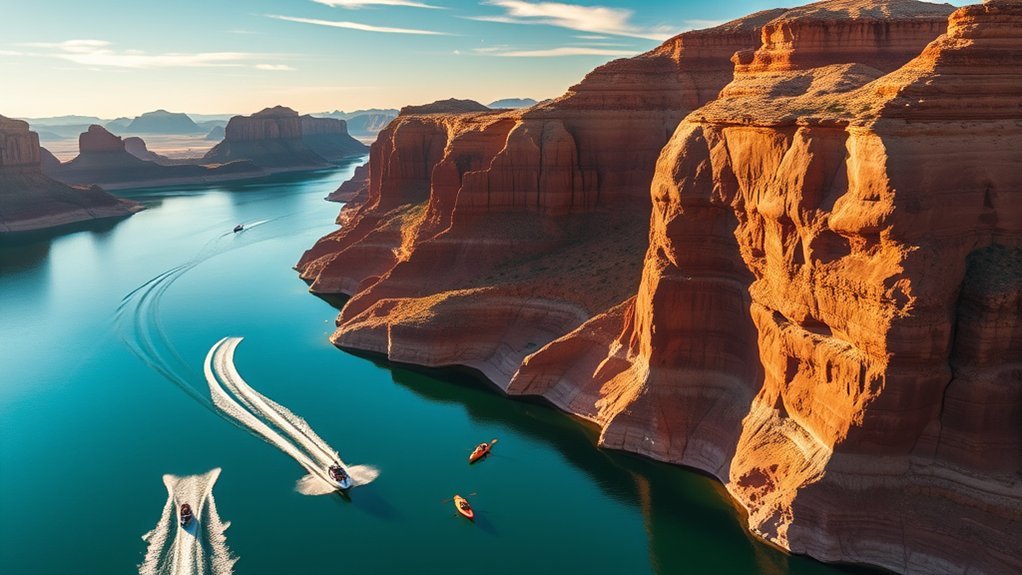
Often you’ll find the water shimmering like glass at dawn, and renting a jet ski or kayak is the fastest way to turn that sight into an unforgettable experience; zip out to secluded coves, glide through red-rock cliffs, or paddle into narrow canyons where the light plays on the sandstone. You’ll feel cool spray on your face from a jet ski as you skim open water, wind shifting the heat off the canyon walls. In a kayak, you’ll sit low, hear only your paddle and bird calls, and slip into quiet side-arms that big boats can’t reach. Rental shops at Wahweap and Antelope Point offer guided tours, safety briefings, life jackets, and maps showing shallow hazards and buoyed channels. Check water levels and wind forecasts before heading out; Lake Powell’s shoreline changes with seasons. Bring sunscreen, plenty of water, and a dry bag for phones. Whether you crave speed or solitude, the contrast of blue water and red rock will stay with you long after you dock.
Lees Ferry Historic Site
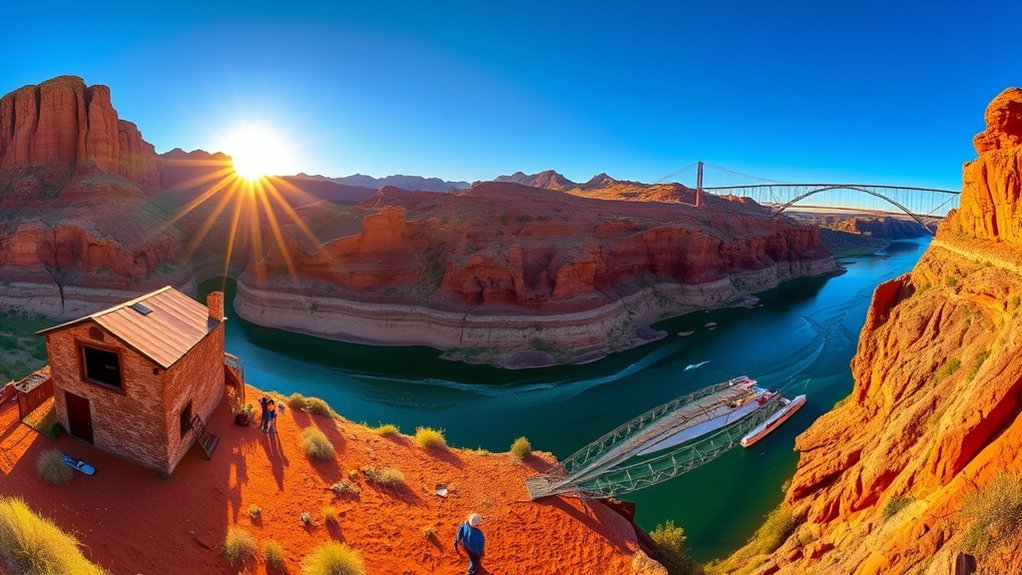
Step back into the spot where the Colorado River narrows and history clings to the canyon walls: Lees Ferry Historic Site lets you feel the pulse of early river travel and ranch life while standing where cowboys, steamboats, and rafters once converged. You’ll wander a compact landscape where the river’s glassy current contrasts with red-rock cliffs and the hush of sage. Interpretive signs plot the ferry’s role in frontier migration; a simple stone cabin and corrals evoke the grit of ranching families. You can watch anglers snag trout below the gentle rapids, or trace the old crossing where ferries once shuttled people and livestock. Bring sturdy shoes and a breeze-ready jacket—the air here smells of river and sun-warmed sandstone.
- Weathered ferry landing stones and iron rings underfoot.
- Rippled green water cutting a bright ribbon through rust cliffs.
- A solitary cabin silhouette against wide, open sky.
- Anglers’ lines and the soft slap of water on rock.
Night Sky and Stargazing Spots
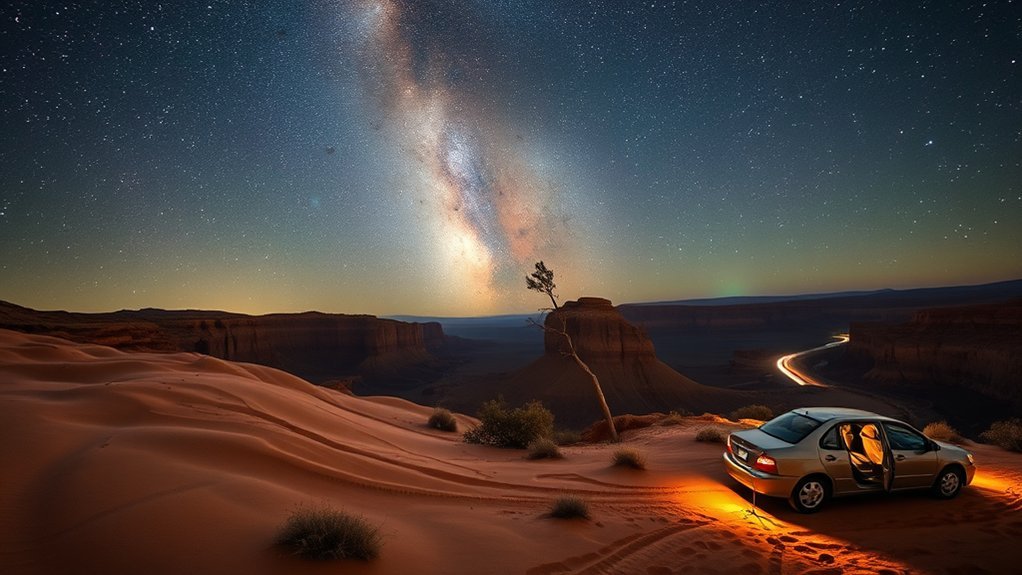
When night falls around Page, you’ll find wide-open dark sky viewing areas where the Milky Way spills crystal-clear across the desert. Bring a blanket and binoculars or set up a tripod at known astrophotography hotspots to capture long-exposure shots of star trails and the faint glow of distant nebulae. The silence and cool air sharpen every pinprick of light, so you’ll want to stay until the sky puts on its full show.
Dark Sky Viewing Areas
Night after night, Page’s desert skies open into a vast, jewel-studded ceiling that feels within reach — crisp air, a faint scent of sage, and the Milky Way arcing overhead. You’ll find pockets of darkness where towns fade and stars flood your vision. Drive to overlooks, settle on hooded blankets, and let constellations orient you; listen for night insects and feel the chill deepen. Choose spots with minimal light, stable footing, and wide horizons to the south.
- Lone mesa rim — silhouette of red rock framing the Milky Way.
- Riverside bend — water mirrors pinpricks of light.
- Gravel pullout — flat, open view with cold sand underfoot.
- Desert wash — wide sky, whispering sage nearby.
Astrophotography Hotspots
Though the desert seems silent, Page’s skies are alive for photographers ready to chase stars: crisp air sharpens outlines, distant sodium lights stay low, and the Milky Way spills color across horizon arcs. You’ll find prime frames at Horseshoe Bend Overlook before dawn, where river reflections anchor star trails. At Lone Rock Beach you can set up on sand, compose with Glen Canyon’s silhouette, and catch meteor streaks over dark water. Head to the Vermilion Cliffs for undisturbed panoramas and minimal light domes. Use a wide-aperture lens, set ISO for clean detail, and bracket exposures for shadow texture. Scout locations by day, note foreground interest, and let long exposures transform the desert into a luminous, patient canvas.
Antelope Point Marina
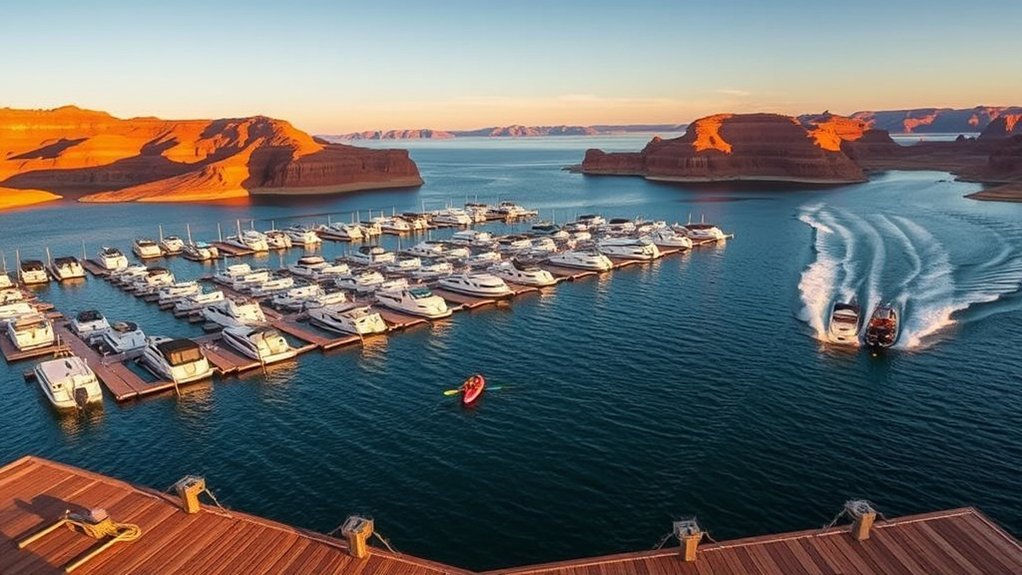
A gentle breeze off Lake Powell greets you as you step onto Antelope Point Marina, where wide slips, rental boats, and sun-baked docks promise easy access to the canyon-carved waters. You can feel heat rising from red sandstone, hear water lapping against hulls, and smell diesel and sunblock mingling with pine. The marina is practical and picturesque: kayaks and houseboats wait, staff help you launch, and maps point to hidden inlets. Whether you’re setting out at dawn or returning under a violet sunset, the marina frames your movement across glassy backwaters and under soaring sandstone cliffs.
- Bright rental kayaks lined like colored pencils against weathered wood.
- Houseboats bobbing gently, their decks warm beneath your bare feet.
- Narrow canyons opening to mirror-still coves where ospreys patrol.
- Sun-bleached signs and rope-wrapped pilings, textured with salt and sand.
You leave with hands tinged by sun and a clear sense of water-shaped geology to explore.
Guided Canyoneering and Climbing Tours
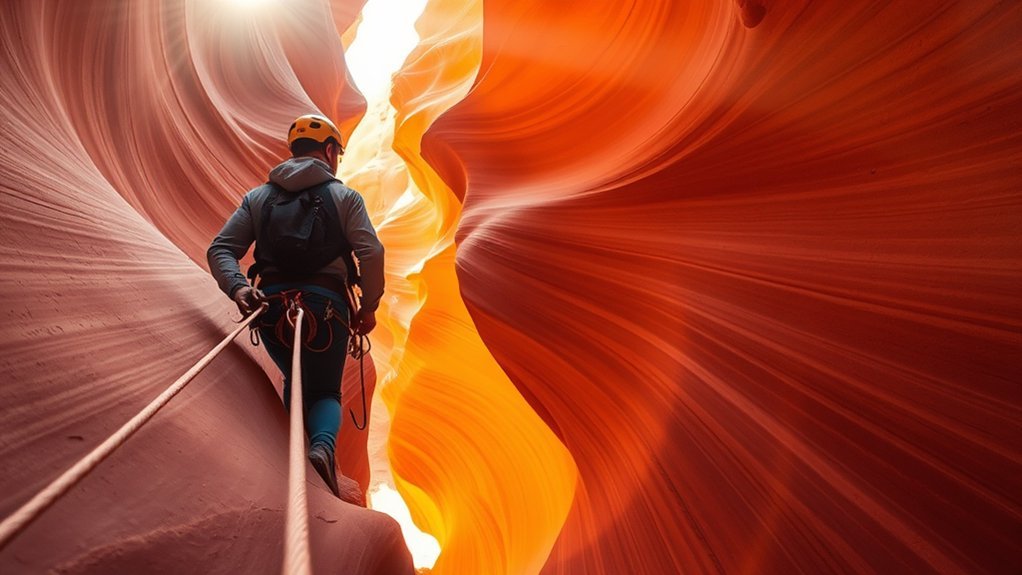
After a day on the water, swap the bobbing houseboats for chalked hands and rope—guided canyoneering and climbing tours take you up and into Page’s sandstone sculptures. You’ll clip into harnesses, listen as guides point out handholds polished by wind and time, then step onto warm, sunbaked edges that smell faintly of dust and desert bloom. Rappels lower you into shadowed narrows where the air cools, echoing your movements, while climbs reward you with sweeping views of canyons carved into impossible shapes.
Guides teach technical skills—anchor building, rope management, route finding—so you gain confidence without guesswork. They read rock faces and weather, choosing lines that match your ability, and share local lore about the formations you touch. Expect gritty texture under your palms, the thud of your boots on packed sand, and panoramic light that shifts from harsh noon to golden dusk. These tours are active, immersive, and anchored in safety, turning raw landscape into hands-on adventure.
Horseback Riding Tours With Navajo Guides
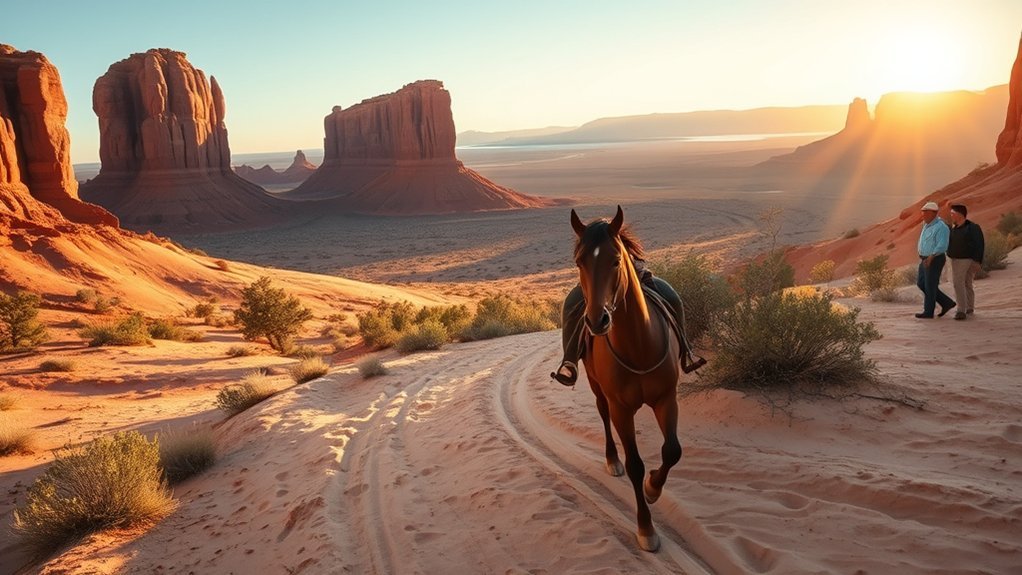
When you climb into the saddle with a Navajo guide, the desert opens at a slower, older pace—hooves thudding softly on packed earth as stories about the land and its people unfold between gulches and red mesas. You breathe sage and sun-warmed leather while the guide points out ancestral trails, medicinal plants, and rock art niches you’d miss on foot. The horses move steady; you feel the rhythm in your thighs and the wind on your face. Tours vary from short ridge rides at dawn to full-day canyon loops that include shaded washes and panoramic overlooks. You learn Navajo place names and the practical wisdom tied to water, weather, and survival.
- Sunlight carving canyon walls into ribbons of gold and rust.
- The distant call of ravens echoing off stone.
- The smell of resinous juniper when a breeze stirs.
- Quiet moments where only hoofbeats break the silence.
Photography Workshops and Guided Photo Tours
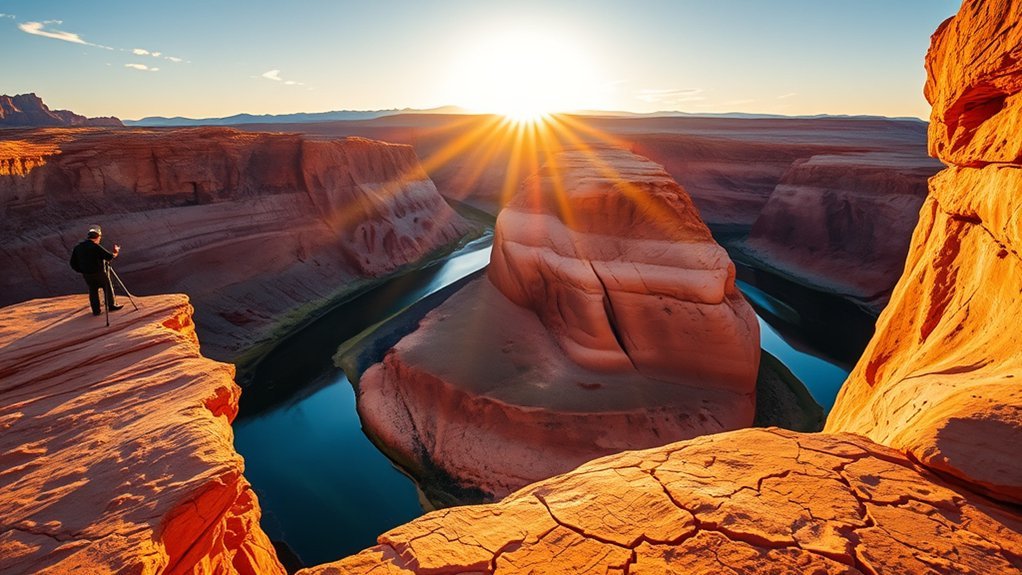
Leave the saddle and pick up a camera: guided photo outings will teach you to see the same mesas, washes, and petroglyphs through light and lens. You’ll start before dawn, when chill air and gold edges carve the landscape; instructors point out angles, exposure tricks, and how to use native foregrounds to add scale. Midday sessions focus on texture—sandstone ripples, lichen, and shadow play—while sunset workshops teach color layering as cliffs glow from amber to violet. Small groups let guides give hands-on feedback; they’ll demo polarizers, graduated filters, and simple composition shifts that transform snapshots into stories. You’ll learn to read weather and plan shots around fleeting conditions—cloud bands, dust devils, or reflected water in seasonal pools. Expect practical post-processing tips, file management, and ethical guidance for photographing cultural sites. Walk away with stronger technical skills, a sharper eye for the desert’s subtle drama, and a curated set of images that really feel like Page.
Scenic Helicopter Tours Over Lake Powell and Canyons
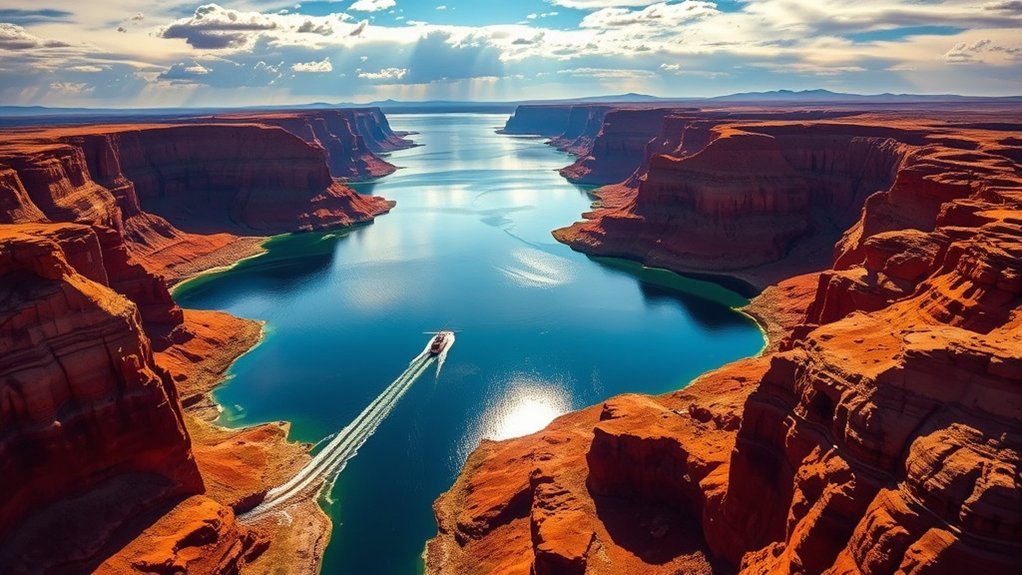
A helicopter lifts you above Lake Powell’s glassy inlets and rust-colored amphitheaters, turning familiar sandstone fins into a cinematic sweep of shadow and light; you’ll feel the hush of altitude, smell sun-warmed resin, and watch wind-sculpted water trace impossible contours below. You’ll ride low enough to read the coastline’s striations yet high enough to sense the basin’s vastness. Pilots narrate geology and point out hidden alcoves, offering timed windows for photos and quiet moments to absorb scale. Tours vary in length and landing options; some set you down on remote benches for a brief walk.
- Copper cliffs glowing at golden hour, their layers like pages of deep time.
- Narrow slot canyons revealed as slivers of darkness slicing the ochre.
- Turquoise coves cupped by white sandstone beaches, unreachable by road.
- The dam and river confluence, miniature in the sky, hinting at human scale.
Book a reputable operator, check weight limits, and bring polarized lenses.
Local Art Galleries and Shops in Page
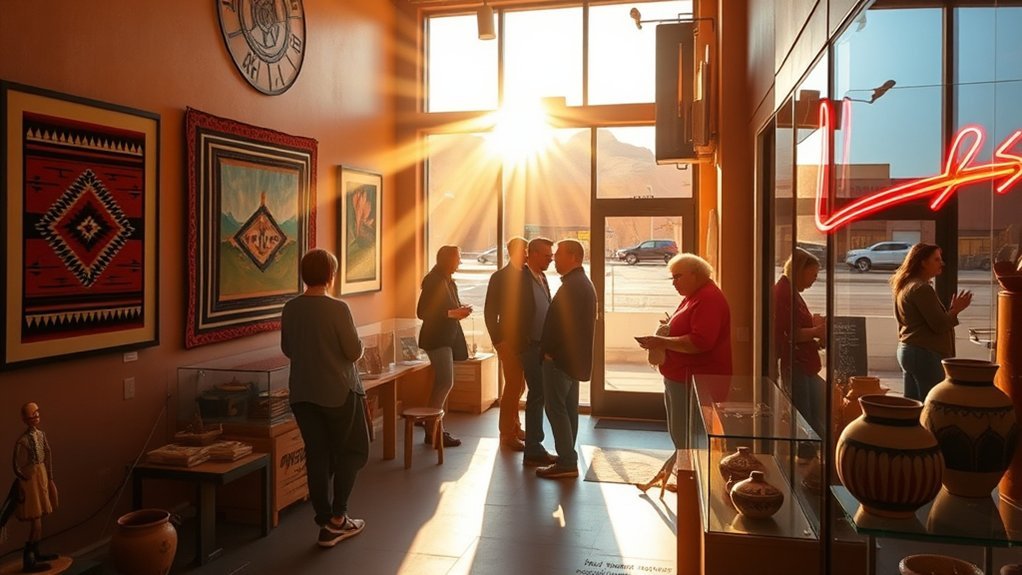
Step into Page’s compact gallery scene and you’ll find art that feels grown from the desert itself—paintings that echo sandstone striations, jewelry threaded with turquoise the color of hidden coves, and photographs that trap the canyon’s light. You’ll wander small storefronts where local painters display acrylic washes of ochre and sienna, and photographers offer crisp prints of Antelope Canyon’s shafts of gold. Touch handcrafted silver and turquoise pieces cooled by desert nights; listen to shop owners share provenance stories of stones and techniques. Pick up landscape watercolors, handmade pottery with sandy textures, or postcards that will remind you of a specific light at sunset. Galleries often double as studios, so you might catch an artist at work, the scent of oil and clay in the air. Whether you’re hunting a one-of-a-kind keepsake or seeking inspiration, these intimate spaces let you connect with Page’s landscape through objects crafted by hands that know it well.
Frequently Asked Questions
Are Permits Required for Backcountry Hiking in Nearby National Monuments?
Yes — you’ll often need permits for backcountry hiking in nearby national monuments. Check specific monument rules; some areas limit access, require free or paid permits, and enforce quotas to protect fragile landscapes and wildlife during peak seasons.
What Are the Best Months for Avoiding Crowds in Page?
Visit in late fall (October–November) or early spring (March–April); you’ll enjoy cooler light, softer crowds, quieter trails, and dramatic sunsets while you inhale desert sage, feel sandstone warmth, and savor spacious views without the summer crush.
Where Can I Find Emergency Medical Services in Page?
Think of help as a nearby lighthouse: you’ll find emergency medical services at Lakeview Hospital Emergency Center on 500 S Navajo Dr, Page; call 911 for urgent response, or use local clinics and urgent care for non-life-threatening issues.
Are There Accessible Trails and Facilities for Visitors With Disabilities?
Yes — you’ll find accessible trails and facilities, including paved overlooks at Horseshoe Bend and visitor centers with ramps, accessible restrooms, and designated parking; service animals are allowed, and staff can help plan sensory-friendly, wheelchair-accessible experiences.
What Are Local Regulations for Drone Use Over Public Lands?
You must follow FAA rules and obtain permits for flying over national parks, tribes’ lands, and certain reservoirs; county or state restrictions may apply, so check signs, secure permission, avoid crowds, and respect wildlife and cultural sites.
Conclusion
Let Page’s red stone be your compass — each canyon slot, rippling lake, and sun-slit rim a chapter you can touch. You’ll taste warm Navajo coffee, feel sand sift through fingers, and hear water carving time. Keep a steady, respectful step: every footprint is a quiet promise to the land. When you leave, carry the place like a pocketstone — small, heavy with memory, guiding you back to wonder and careful curiosity.

